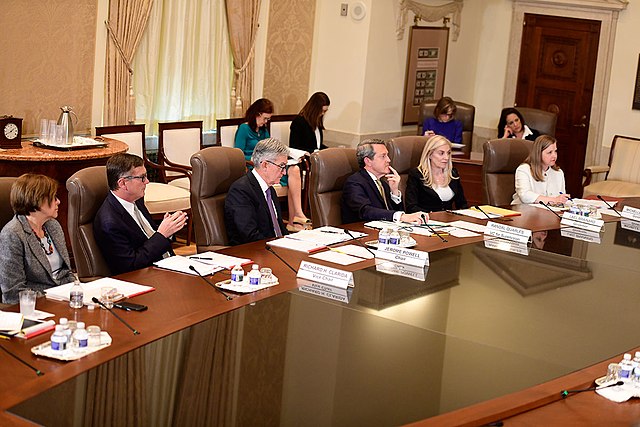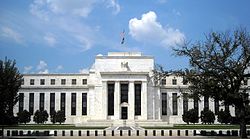Top Qs
Timeline
Chat
Perspective
Federal Reserve Board of Governors
Governing body of the U.S. Federal Reserve System From Wikipedia, the free encyclopedia
Remove ads
The Board of Governors of the Federal Reserve System, commonly known as the Federal Reserve Board, is the main governing body of the Federal Reserve System of the United States of America. It oversees the Federal Reserve Banks and the implementation of the monetary policy of the United States.
Each governor is appointed by the president of the United States and confirmed by the Senate to staggered 14-year terms, such that the tenures of all seven members span multiple presidential and congressional terms. Members who have served a full term are not eligible for reappointment, although governors who were initially appointed to serve an uncompleted term may be reappointed to a full term.
All seven board members of the Federal Reserve Board of Governors, along with the five Federal Reserve Bank presidents, are members of the Federal Open Market Committee, which directs the open market operations that sets monetary policy. The law provides for the removal of a member of the board by the president "for cause".
The chair and vice chair are appointed by the president from among the sitting Governors. They both serve a four-year term and can be renominated by the president as many times until their terms on the Board expire. The current chair is Jerome Powell; the current vice chair is Philip Jefferson. The Federal Reserve Board is headquartered in the Eccles Building on Constitution Avenue, N.W. in Washington, D.C.
Remove ads
Statutory description
Summarize
Perspective

Governors are appointed by the president of the United States and confirmed by the Senate for staggered 14-year terms.[5][6] By law, the appointments must yield a "fair representation of the financial, agricultural, industrial, and commercial interests and geographical divisions of the country".[5][6] As stipulated in the Banking Act of 1935, the chair and vice chair of the Board are two of seven members of the Board of Governors who are appointed by the president from among the sitting governors of the Federal Reserve Banks.[5][6]
The terms of the seven members of the Board span multiple presidential and congressional terms. Once a member of the Board of Governors is appointed by the president, the members function mostly independently. Such independence is unanimously supported by major economists.[7] The Board is required to make an annual report of operations to the Speaker of the House.[8] It also supervises and regulates the operations of the Federal Reserve Banks, and the U.S. banking system in general. The Board obtains its funding from charges that it assesses on the Federal Reserve Banks, and not from the federal budget, though net earnings of the Federal Reserve Banks are ultimately remitted to the US Treasury.[9]
Membership is by statute limited in term, and a member who has served for a full 14-year term is not eligible for reappointment.[10] However, individuals have been appointed to serve the remainder of another member's uncompleted term and thereafter reappointed to serve a full 14-year term.[10] Since "upon the expiration of their terms of office, members of the Board shall continue to serve until their successors are appointed and have qualified",[10] a member can serve for significantly longer than a full term of 14 years. The law provides for the removal of a member of the board by the president "for cause".[10]
The chair and vice chair of the Board of Governors are appointed by the president from among the sitting Governors. They both serve a four-year term and they can be renominated as many times as the president chooses until their terms on the Board of Governors expire.[5]
All seven board members of the Federal Reserve Board of Governors and five Federal Reserve Bank presidents direct the open market operations that set U.S. monetary policy through their membership in the Federal Open Market Committee (FOMC).[11]
Records of the Federal Reserve Board of Governors are found in the Record Group n. 82 at the National Archives and Records Administration.[12]
Remove ads
Current members
Summarize
Perspective
The current members of the Board of Governors are as follows:[13]
- On August 25, 2025, President Donald Trump announced that he was removing Cook from the Federal Reserve Board of Governors, citing alleged misconduct. Federal law allows governors to be removed only “for cause,” a provision intended to protect the central bank’s independence. Cook disputed the allegations and filed suit in federal court, arguing that her dismissal was unlawful and politically motivated. As litigation proceeds, she remains legally considered an active governor,[14] pending a judicial ruling on whether the president had authority to remove her.
Remove ads
Committees

There are eight committees.[15]
- Committee on Board Affairs
- Committee on Consumer and Community Affairs
- Committee on Economic and Financial Monitoring and Research
- Committee on Financial Stability
- Committee on Federal Reserve Bank Affairs
- Committee on Bank Supervision
- Subcommittee on Smaller Regional and Community Banking
- Committee on Payments, Clearing, and Settlement
List of governors
Summarize
Perspective


The following is a list of past and present members of the Board of Governors of the Federal Reserve System. A governor serves for a fourteen-year term after appointment and a member who serves a full term may not be reappointed; when a governor completes an unexpired portion of a term, they may be reappointed. Since the Federal Reserve was established in 1914, the following people have served as governor.[16]
Status
- Italics denotes date of term expiration
Remove ads
Succession of seats
Summarize
Perspective
The Federal Reserve Board has seven seats subject to Senate confirmation, separate from a member's term as chair or vice chair.[16][18][19][20]
Remove ads
Structure of leadership
Summarize
Perspective
The chair, vice chair, and vice chair for supervision are appointed by the president from among the sitting members of the board to serve a four-year term and they can be renominated as many times as the president chooses, subject to Senate confirmation each time, until their terms on the Board of Governors expire.[16]
Remove ads
Nominations, confirmations, and resignations
Summarize
Perspective
Obama administration
In late December 2011, President Barack Obama nominated Jeremy C. Stein, a Harvard University finance professor and a Democrat, and Jerome Powell, formerly of Dillon Read, Bankers Trust[21] and The Carlyle Group[22] and a Republican. Both candidates also have Treasury Department experience in the Obama and George H. W. Bush administrations respectively.[21]
"Obama administration officials [had] regrouped to identify Fed candidates after Peter Diamond, a Nobel Prize-winning economist, withdrew his nomination to the board in June [2011] in the face of Republican opposition. Richard Clarida, a potential nominee who was a Treasury official under George W. Bush, pulled out of consideration in August [2011]", one account of the December nominations noted.[23] The two other Obama nominees in 2011, Janet Yellen and Sarah Bloom Raskin,[24] were confirmed in September.[25] One of the vacancies was created in 2011 with the resignation of Kevin Warsh, who took office in 2006 to fill the unexpired term ending January 31, 2018, and resigned his position effective March 31, 2011.[26][27] In March 2012, U.S. Senator David Vitter (R, LA) said he would oppose Obama's Stein and Powell nominations, dampening near-term hopes for approval.[28] However, Senate leaders reached a deal, paving the way for affirmative votes on the two nominees in May 2012 and bringing the board to full strength for the first time since 2006[29]with Duke's service after term end. Later, on January 6, 2014, the United States Senate confirmed Yellen's nomination to be chair of the Federal Reserve Board of Governors; she was the first woman to hold the position.[30] Subsequently, President Obama nominated Stanley Fischer to replace Yellen as the vice-chair.[31]
In April 2014, Stein announced he was leaving to return to Harvard on May 28 with four years remaining on his term. At the time of the announcement, the FOMC "already is down three members as it awaits the Senate confirmation of ... Fischer and Lael Brainard, and as [President] Obama has yet to name a replacement for ... Duke. ... Powell is still serving as he awaits his confirmation for a second term."[32]
Allan R. Landon, former president and CEO of the Bank of Hawaii, was nominated in early 2015 by President Obama to the board.[33]
In July 2015, President Obama nominated University of Michigan economist Kathryn M. Dominguez to fill the second vacancy on the board. The Senate had not yet acted on Landon's confirmation by the time of the second nomination.[34]
Daniel Tarullo submitted his resignation from the board on February 10, 2017, effective on or around April 5, 2017.[35]
Unsuccessful
The below table shows those who were formally nominated to fill a vacant seat but failed to be confirmed by the Senate.
In addition some have been announced but never formally nominated before being withdrawn from consideration. Alicia Munnell, representing Boston, was announced to fill LaWare's seat by Bill Clinton in 1995.[36] Felix Rohatyn (district unknown) was announced to fill Alan Blinder's as vice chair and his seat in 1996.[37] Steve Moore and Herman Cain were announced to fill Bloom Raskin and Yellen's seats (without specifying which seat or district) by Donald Trump in 2019.[38][39]
Remove ads
See also
- Banking Act of 1933 and 1935 - created and gave voting rights to the seven Federal Reserve Board of Governors appointed by the president and 12 Federal Open Market Committee members.
References
External links
Wikiwand - on
Seamless Wikipedia browsing. On steroids.
Remove ads










